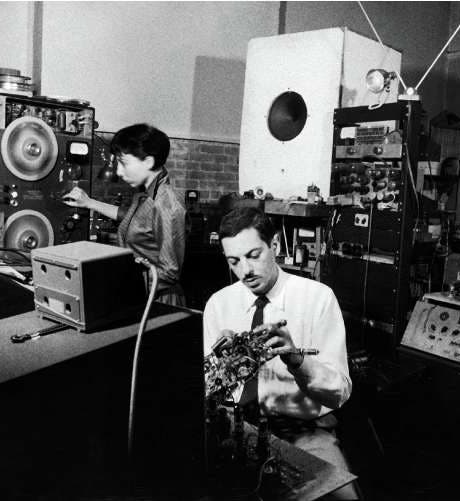Scientist of the Day - Bebe and Louis Barron
Bebe Barron, an electronic music composer, was born June 16, 1925, in Minneapolis. She studied music composition, and met a fellow student, a pianist, Louis Barron, who was more interested in electronics than playing music. They married in 1947 and moved to Greenwich Village. One of their wedding presents, given to them by a friend who worked at 3M in Minneapolis, was a reel-to-reel tape recorder. They both became interested in recording sounds and then tinkering with the sounds by manipulating the recorder – speeding it up and slowing it down, reversing it, splicing pieces of taped sounds together. Louis began designing electronic circuits to generate sounds, which could also be recorded and then further manipulated. The two became part of an avant garde scene in New York City that included Anaïs Nin and John Cage. Cage especially encouraged them to pursue the creation of electronic music. They scored a film for Nin in 1952.
Their big chance came when they were given the opportunity to supply some electronic sounds for a new science fiction film then in production in Hollywood, Forbidden Planet. The eerie sounds they created greatly impressed the producer, and soon the entire musical score was theirs to construct. It was arduous work. Louis generated and recorded sounds from his vacuum-tube based circuits, producing miles of tape. He would overload the circuits until they fried, and the resulting tones were indeed unearthly. Bebe was the “composer”, turning Louis’s electronic moans and howls into what they hardly dared to call music. It was Cage who convinced Bebe that she was making music, not just sound effects. I am not sure a Cage endorsement of musicality was convincing to many mainstream musicians.
The film, released in 1956, was a great success, filmed in full-color CinemaScope, with a top-notch cast featuring Leslie Nielsen, Anne Francis, Walter Pidgeon, and Robby the Robot, and with an intriguing plot, involving refugees on the planet Altair IV, formerly inhabited by the mysterious Krell. I wrote a post once on Pidgeon’s character, Edward Morbius. But the score was as memorable as the sets or the machines of the Krell or Anne Francis’s wardrobe. The eerie bleeps and glissandos were just perfect for the other-worldly setting of the film. Even more intriguing, the sound effects and the musical score were one and the same, a feature never before seen in a major motion picture. Here are links to two short video clips from the film, with the Barrons’ soundtrack, the first showing the landing of the starship on Altair IV, the second the invisible “Monster from the Id” plodding across the planetscape on its nefarious mission. And here is a third video, a demonstration with two tape recorders, showing how the sounds for the electronic score were produced.
Bebe and Louis were prevented by the Musicians’ Union from taking credit for a musical score; instead, they were credited for contributing “electronic tonalities.” And they were thereby prevented from being nominated for an Academy Award for best musical score, which they might well have won (the winner for 1956 was Around the World in Eighty Days). The age of the synthesizer was soon upon us, and electronic music became easy and omnipresent. But somehow, none of the fancy gadgets have come up to the level of Louis Barron and his self-sacrificing circuits, manipulated on tape by Bebe. Some, myself included, consider their work for Forbidden Planet to be the finest and most appropriate musical score ever written for a science fiction film, and that includes 2001: A Space Odyssey.
Here is a link to a final video, in which a much older Bebe comments on the creation of the score for Forbidden Planet, and we see some more scenes from the film.
Dr. William B. Ashworth, Jr., Consultant for the History of Science, Linda Hall Library and Associate Professor emeritus, Department of History, University of Missouri-Kansas City. Comments or corrections are welcome; please direct to ashworthw@umkc.edu.







